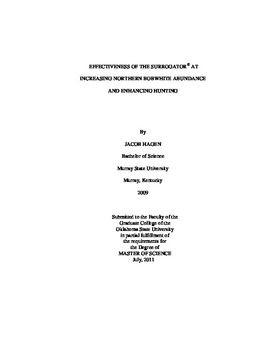| dc.contributor.advisor | Davis, Craig A. | |
| dc.contributor.author | Hagen, Jacob Martin | |
| dc.date.accessioned | 2014-04-15T21:59:43Z | |
| dc.date.available | 2014-04-15T21:59:43Z | |
| dc.date.issued | 2011-07-01 | |
| dc.identifier.uri | https://hdl.handle.net/11244/9171 | |
| dc.description.abstract | The main objectives of this study were to: (1) quantify in-surrogator survival of bobwhite chicks, (2) monitor post-release survival, habitat use, and dispersal, (3) and record rate at which surrogator bobwhite were harvested. In-surrogator survival was recorded by weekly monitoring the surrogator unit and recording mortality. Post-release data were obtained by attaching transmitters to a sample of surrogator bobwhites and using radiotelemtry to track the birds. Habitat use was measured using the Robel pole, Daubenmire frame, line intercept tape, and cone of vulnerability. Bobwhite harvest information was collected by monitoring hunters during the 2009-2011 bobwhite hunting seasons. In-surrogator bobwhite survival was greater than reported for wild bobwhite chicks, resulting in more birds in the population. Post-release survival of surrogator bobwhites was lower than both wild bobwhites and other captive-release studies. Vegetation surveys at surrogator bobwhite locations revealed similar habitat use as wild bobwhites. Dispersal of surrogator bobwhites off release field was common and resulted in lost recreation to hunters. Surrogator bobwhites did supplement hunter harvest of wild bobwhites by an average of 31% per year, but a huntable population of strictly surrogator bobwhites was not established on the release field by that hunting season. Hunters rated surrogator bobwhites as similar to wild birds. Given these findings it appears surrogator bobwhite survival was too low to sustain a huntable population into the hunting season. Further without the presence of natural bobwhite populations hunter-covey encounters during the 2009-2011 bobwhite hunting seasons would have been rare. Some sportsmen and land managers may find use for the surrogator as a tool to supplement wild populations of bobwhites, though hunter opinion of benefits versus costs will vary. | |
| dc.format | application/pdf | |
| dc.language | en_US | |
| dc.publisher | Oklahoma State University | |
| dc.rights | Copyright is held by the author who has granted the Oklahoma State University Library the non-exclusive right to share this material in its institutional repository. Contact Digital Library Services at lib-dls@okstate.edu or 405-744-9161 for the permission policy on the use, reproduction or distribution of this material. | |
| dc.title | Effectiveness of the Surrogator at Increasing Northern Bobwhite Abundance and Enhancing Hunting | |
| dc.type | text | |
| dc.contributor.committeeMember | Guthery, Fred S. | |
| dc.contributor.committeeMember | Elmore, R. Dwayne | |
| osu.filename | Hagen_okstate_0664M_11700.pdf | |
| osu.college | Agricultural Sciences and Natural Resources | |
| osu.accesstype | Open Access | |
| dc.description.department | Department of Natural Resource Ecology and Management | |
| dc.type.genre | Thesis | |
| dc.subject.keywords | wildlife conservation | |
